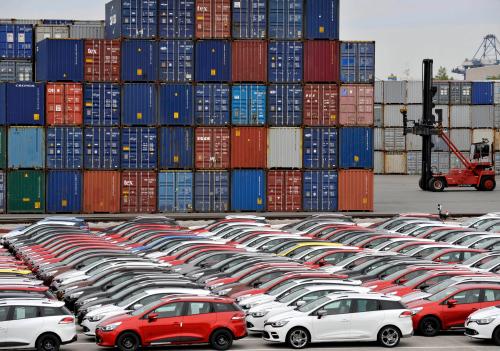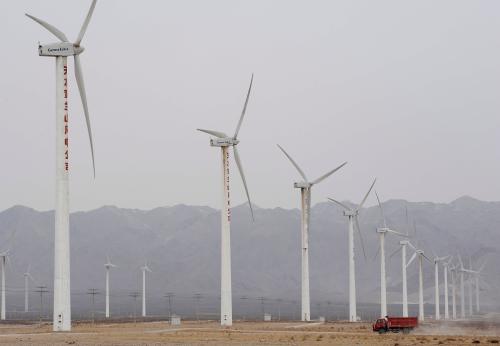When markets closed on January 3, 2017, Ford Motor Co. stock had strengthened by 3.79 percent. That same day, the company announced it would be canceling plans to build a $1.6 billion plant in Mexico and, instead, expand one of its factories in Michigan to produce more cars on American soil. How is it possible that this change of course—which would result in higher costs of production—was so welcomed by markets? The answer: President-elect Donald Trump.
Ford’s investors probably expected that such a move would get the company a sweet deal in the form of tax cuts or other perks, following the precedent set by Mr. Trump when he offered $7 million in state tax credits to Carrier to keep them from relocating production facilities abroad. Certainly, this precedent creates incentives for any large firm to announce relocation in the morning and then retracting in the afternoon. Will the new “dealmaker-in-chief” go firm by firm in negotiations to keep them from relocating? That remains to be seen. However, in parallel, President-elect Trump plans to impose a tariff of 35 percent on imports from any firm, American or not, based outside of the U.S. Trump strongly believes that protectionism is what will protect the American workers. He is wrong.
According to the World Trade Organization (WTO) website, based on 2014 data, the U.S. has an average applied tariff of 3.51 percent for all products being imported from other WTO members (known as the most-favored nation, or MFN, tariff). This is the maximum tariff that the U.S. promises to impose on imports from other WTO members, averaged across all industries. For other nations that the U.S. has a free-trade agreement, such as Canada and Mexico through NAFTA, tariffs are typically lower and in some cases, zero. Mr. Trump is basically advocating for a tenfold increase in the average import tariffs that are already in place. Is any WTO member imposing import tariffs that are anything near 35 percent? Not at all.
When looking at non-agricultural goods, the average MFN import tariff on the US is 3.24 percent. The Bahamas is the only country in the world that has an average tariff for non-agricultural goods above 35 percent, and it is not a fully-fledged member of the WTO. For goods in the manufacturing sector, such as the electrical machinery industry—the category that Carrier would classify in—the average MNF tariff on U.S. products is only 1.66 percent. Some of the WTO members with the highest average tariffs for products in this category are Chad (16.82 percent), Pakistan (14.43 percent), Brazil (14.07 percent), Argentina (14.81 percent), and Zimbabwe (13 percent). For transport equipment, such as cars, the U.S. average MFN tariff is 3.06 percent, whereas some examples of the most protectionist WTO members in that category are Pakistan (24.38 percent), India (21.7 percent), and Thailand (20.68 percent). In short, charging a 35 percent import tariffs to other WTO members is the exception, not the rule. Imposing higher tariffs is, in fact, common only in developing and poor countries.
Beyond making comparisons, it is important to raise a few points on why dramatically raising import tariffs is a bad idea. Not only will it not protect the American worker, it will strongly hurt the American consumer. This is simply because if imports turn out to be more expensive than before, it is the American consumers, and no one else, who will have to pay for that extra 35 percent that will be added to goods’ price tags. Alternatively, one may think, Americans can start consuming more local goods, and therefore their price tags won’t be affected. However, not everything “Made in USA” is cheaper in the U.S.: If these goods were being imported before, it is because American producers were not competitive enough to begin with; therefore, the American version of these goods are more expensive. Also, in the absence of foreign competition, American producers could raise prices, therefore reducing the purchasing power of consumers.
In addition, imposing tariffs do not unequivocally protect American workers. By increasing import tariffs to other WTO members, the U.S. will be more prone to retaliations by its trade partners. Other countries could decide to retaliate by increasing their own import tariffs, putting American jobs in jeopardy, as these exporter firms could harshly suffer from the lower global demand for their products. This is highly critical to consider, as most of the countries that export to the U.S. also import from the U.S. ( China, Canada, and Mexico being the top three).
Of course, the notion that trade has winners and losers isn’t wrong. David Autor, a professor of economics at MIT together with David Dorn from the University of Zurich and Gordon Hanson from the University of California, San Diego, have shown that higher Chinese import penetration in U.S. localities resulted in less manufacturing jobs. But, imports—let alone Chinese imports—cannot account for all U.S. job losses in manufacturing during the last decade. As Harvard Professor Ricardo Hausmann explains in a Project Syndicate piece, a look at the numbers suggests that the manufacturing jobs lost in the US since 1993 (before NAFTA came into effect) until 2014 did not end up in Mexico. Many of these jobs , in fact, went missing due to higher labor productivity and advances in technology and automation, which have little to do with low trade tariffs.
Therefore, the right course of action to protect American workers is not to protect the U.S. from foreign competition but rather to put proper safety nets in place to assist affected workers in their transition to new jobs in advanced manufacturing or the service sector, or even to retirement. Trade protectionism is the wrong policy, not only because it aims to protect the American workers at the expense of the consumers, but also because it will harm the most important determinant of economic growth: productivity. Competition, which foreign trade is a crucial part of, is one of the most important sources of wealth, productivity, and economic growth. If the president-elect ignores this, he will fail in his mission of bringing greatness to America.
The Brookings Institution is committed to quality, independence, and impact.
We are supported by a diverse array of funders. In line with our values and policies, each Brookings publication represents the sole views of its author(s).







Commentary
Trump’s trade policy: protecting American workers at the expense of American consumers
January 6, 2017